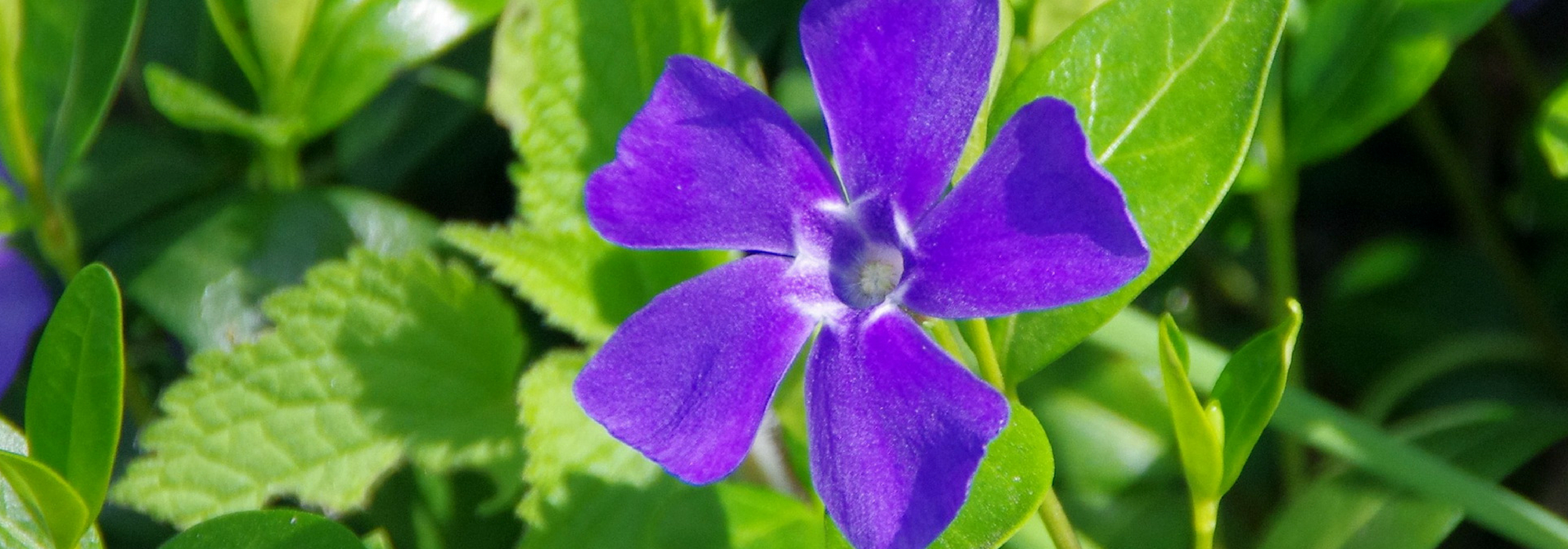
Periwinkle: planting, growing and care
Contents
Periwinkle in a nutshell
- This hardy perennial ground cover establishes itself effectively in shaded and low-traffic areas of the garden
- With their lovely blue, purple, or white colour, the flowers of periwinkle brighten up woodland banks, the edges of paths, and even hanging baskets from early spring
- Its vibrant green or variegated evergreen foliage quickly forms an attractive thick tapetum all year round
- Easy to care for, it thrives in both shade and sun, in all types of cool soil, and is not afraid of drought or frost
- Periwinkle requires no maintenance other than controlling its growth, and it avoids weeding!
A word from our expert
The simplicity of the Periwinkle flower does not prevent it from adding a charming touch to the most shaded or difficult spots in the garden, dressing them with its shiny evergreen foliage and spring flowering, which can be blue, violet, or white.
No, periwinkle no longer refers to a Parisian police officer from the 1970s wearing a “periwinkle blue” uniform, but rather to a delightful perennial ground cover that thrives in all cool terrains.
Periwinkles or vinca are essential for quickly covering an area and preventing weeding, forming thick, slightly bushy mats of pretty star-shaped flowers.
From Vinca minor or lesser periwinkle to Vinca major, the greater periwinkle, from white periwinkle to blue-violet periwinkle, including variegated periwinkle, all revive the undergrowth, the edges of paths, and slopes from April to June and sometimes as early as February.
With their rustic appearance, they also find their place in pots, hanging planters on balconies or windows, and of course in suspensions.
These horticultural varieties of periwinkle are as robust and hardy as wild periwinkle (V. minor), with the exception of the “Pink Periwinkle“, a tender cousin grown as an annual in our climates.
Once used for its medicinal properties, periwinkle is now one of those perennials well-suited to shade, valuable for colonising and brightening areas at the foot of trees.
Make your choice from our unique collection of periwinkles, these ground covers of the undergrowth that thrive in all exposures and in all soils!

Flowers of periwinkles: Vinca minor ‘Flower Power’, Vinca minor ‘Gertrude Jekyll’, Vinca major.
Description and botany
Botanical data
- Latin name Vinca
- Family Apocynaceae
- Common name Periwinkle
- Flowering from February March to June and then in September October depending on the species
- Height 10 to 30 cm
- Exposure Sun, partial shade
- Soil type All
- Hardiness -15°C minimum
La Periwinkle or Vinca is a perennial with a creeping habit that belongs to the Apocynaceae family. Native to the undergrowth of Europe, North Africa, and Central Asia, it grows spontaneously in France, colonising woods, hedges, rocks, shaded rockeries, or even dry meadows scorched by the sun.
Vinca minor, lesser periwinkle or wild periwinkle, and greater periwinkle (Vinca major) are the best-known of the seven species in the Vinca genus. They are very similar and are mainly distinguished by their height and flower size.
They come in horticultural varieties offering variegated foliage, golden or even white or purple flowers. Although sharing the same vernacular name as our woodland periwinkle, the Madagascar Periwinkle (Catharanthus roseus), Vinca rosea or “pink periwinkle”, endemic to Madagascar, does not belong to the same genus; this tender perennial is grown as an annual in our climates.
The lesser periwinkle, which does not exceed 10 to 15 cm, is shorter than the greater periwinkle, which can easily reach 30 cm in height. The habit is prostrate, trailing or erect depending on the species and varieties.
Both are perennials that develop from a woody base producing woody stems that quickly form a dense ground cover. Vinca minor offers upright stems, while Vinca major develops sprawling stems.
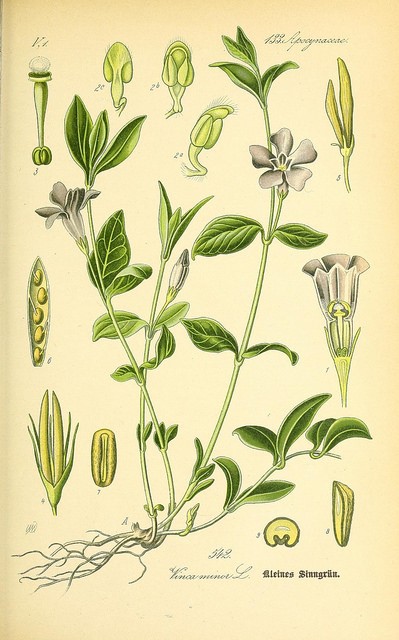
Vinca minor – botanical illustration.
Periwinkle spreads very easily upon contact with the soil, more or less quickly depending on the varieties. Its creeping branches emit adventitious roots that naturally layer and allow it to colonise the surroundings up to sometimes more than 3 m in spread if not contained, giving this charming plant a somewhat invasive character. It takes root at each node, allowing it to colonise any soil.
The stems bear evergreen and leathery leaves, opposite, simple, with pointed tips, oval, sometimes elliptical. Shiny, they measure 3 to 10 cm and are bright green to dark green, variegated or irregularly veined with yellow and cream.
From April to June, and sometimes as early as February, a multitude of small star-shaped flowers in fresh colours emerge from this somewhat bushy vegetation. Some more floriferous varieties (Vinca minor ‘Marie’, ‘Flower Power’) often bloom again in autumn, in September-October.
Blooming solitary in the axil of the leaves and at the end of the stems, the long-pedicelled flowers, composed of five petals fused into a corolla, square-shaped, obliquely truncated, stand upright as they bloom. Measuring 2 to 5 cm in diameter, they are flattened and widely open. In Vinca major, the flowers are larger. The ‘Multiplex’ variety is distinguished by its semi-double flowering.
Alongside the characteristic violet-blue of periwinkle flowers, the “periwinkle blue”, they take on shades ranging from soft blue to dark purple to plum (Vinca minor ‘Atropurpurea’) to pure white. In the violet to blue varieties, the centre of the flower is more or less marked with white.
Periwinkle is a melliferous plant that bees and butterflies love throughout spring.
Very hardy down to at least -15°C, the periwinkle thrives in all regions of France and in all exposures, with a preference for partial shade, making it valuable as a ground cover, especially in woodlands where it quickly forms flowering mats in the shade of trees. It adapts wonderfully to all types of well-drained soils, even poor ones, remaining sufficiently moist in summer.

Periwinkles can have beautiful variegated foliage, decorative all year round.
In Latin, “vinca” means “to conquer”, a fitting name for this perennial with exceptional hardiness, triumphing each year over the rigours of winter, unless its vernacular name refers to its medicinal properties, a beautiful plant capable of overcoming diseases.
Main species and varieties
Vinca minor, the lesser periwinkle and Vinca major, the greater periwinkle are the most common species in our gardens. Most periwinkles are quite low-growing. They are primarily distinguished by their size, with the lesser periwinkle not exceeding 20 cm in height, while the greater periwinkle can reach 50 cm, and the diameter of the flowers is larger in Vinca major.
Each species is available in several varieties offering variegated foliage (‘Variegata’), golden leaves, or even white flowers (‘Alba’) or deep plum (‘Atropurpurea’). Some periwinkles even have a perpetual flowering in autumn!
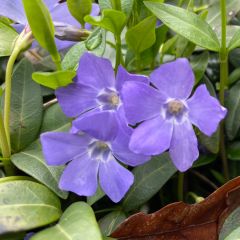
Vinca major
- Flowering time May to July
- Height at maturity 30 cm
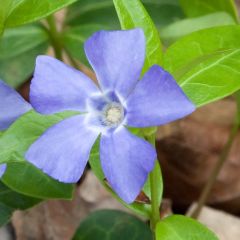
Vinca minor Marie
- Flowering time March to October
- Height at maturity 20 cm
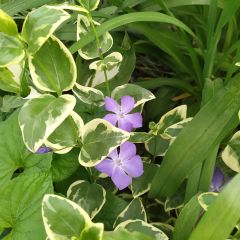
Vinca major Variegata
- Flowering time May to July
- Height at maturity 30 cm
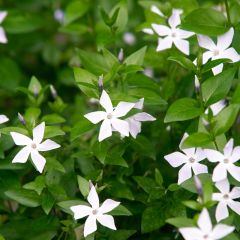
Vinca major Alba
- Flowering time May to July
- Height at maturity 30 cm
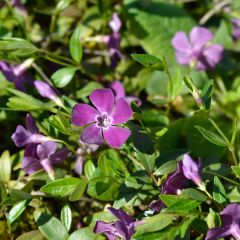
Vinca minor Atropurpurea
- Flowering time April to June
- Height at maturity 20 cm
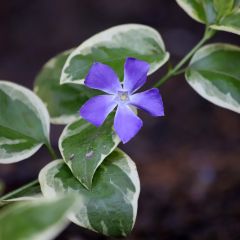
Vinca minor Argenteovariegata
- Flowering time May, June
- Height at maturity 10 cm
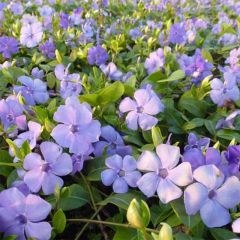
Vinca minor Flower Power
- Flowering time March to November
- Height at maturity 15 cm
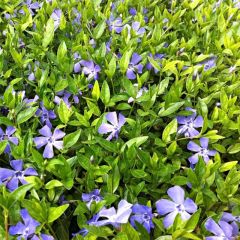
Vinca minor Josefine
- Flowering time April to December
- Height at maturity 15 cm
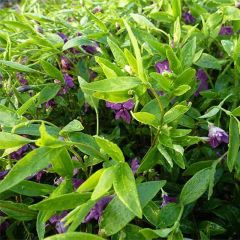
Vinca minor Multiplex
- Flowering time April to June
- Height at maturity 15 cm
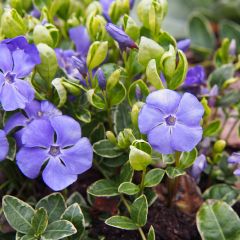
Vinca minor Ralph Shugert
- Flowering time May to July
- Height at maturity 15 cm
Discover other Vinca - Periwinkle
View all →Available in 1 sizes
Available in 2 sizes
Available in 1 sizes
Available in 2 sizes
Available in 1 sizes
Available in 0 sizes
Available in 0 sizes
Available in 2 sizes
Available in 2 sizes
Available in 2 sizes
Planting
Where to plant periwinkle?
The periwinkle is a very hardy plant (down to -15°C), easy to grow throughout France. While periwinkle is mainly a shade plant in cool soil, it will happily grow in full sun, preferring light shade in the hottest regions. In the northern regions of France, it will be more floriferous in full sun, with its flowering being slightly less generous in the shade. Heat does not faze it as long as the soil remains cool.
Accommodating, it perfectly tolerates limestone and poor soils but will thrive in any good garden soil that is light and cool and does not dry out, even though it handles summer drought very well.
Periwinkle is a useful ground cover capable of smothering adventive plants in difficult areas of the garden, thus reducing weeding chores! It eventually forms mats of starry flowers against a glossy green backdrop that brighten up slightly wild undergrowth and shaded corners of the garden.
This spreading plant needs space; it can even become invasive. It will easily naturalise, insinuating itself without hesitation among the roots of trees it does not fear. Some varieties form a ground cover mat in just 1 or 2 years. In borders, it tends to smother neighbouring plants.
It is used in rockeries, in mass plantings in path borders, at the foot of a poorly exposed wall, on a slope, under conifers, or in an herbaceous border. It also makes a statement when planted alone, in pots and hanging baskets from which it will cascade, escaping from any container offered, in search of soil suitable for its rampant nature.
When to plant periwinkles?
Periwinkles are preferably planted in autumn from September to November or in spring from March to May after the frosts.
How to plant periwinkle?
In open ground
The periwinkle is a very easy perennial that can grow in a wide range of soils. However, it shows a preference for drained soils that remain cool during the summer. Space the plants at least 40 cm apart to allow the stems to stretch comfortably. Count on 3 to 5 buckets per m²; given the beautiful development of this perennial, this will be sufficient to effectively cover a large area.
- Dig a hole 2 to 3 times the volume of the pot
- Position the clumps of periwinkle
- If necessary, plant in a mixture of well-matured compost and garden soil
- Fill in with soil to securely encase the roots
- Firm the soil well and then water regularly for the first few weeks to encourage rooting
Planting periwinkle in pots
Place the periwinkle buckets alone in a pot or hanging basket in partial shade. It is best to plant them alone as periwinkle does not tolerate competition well and may invade or even smother neighbouring plants.
- Spread a good layer of drainage material (gravel or clay balls) at the bottom of the pot
- Plant in a mixture of potting soil, compost, and sand
- Water regularly
→ Learn more about growing periwinkle in pots in our advice sheet!
Care and maintenance of periwinkle
The Periwinkle requires no maintenance and proves to be a worry-free perennial that withstands drought as well as harsh winters. However, periwinkle can be a sometimes invasive ground cover.
The only constraint may be to limit its vigorous growth by removing the stems that have rooted in various places in spring and autumn. Regularly cut back the stems at the end of winter.
To keep the soil cool, water twice a week during the summer.
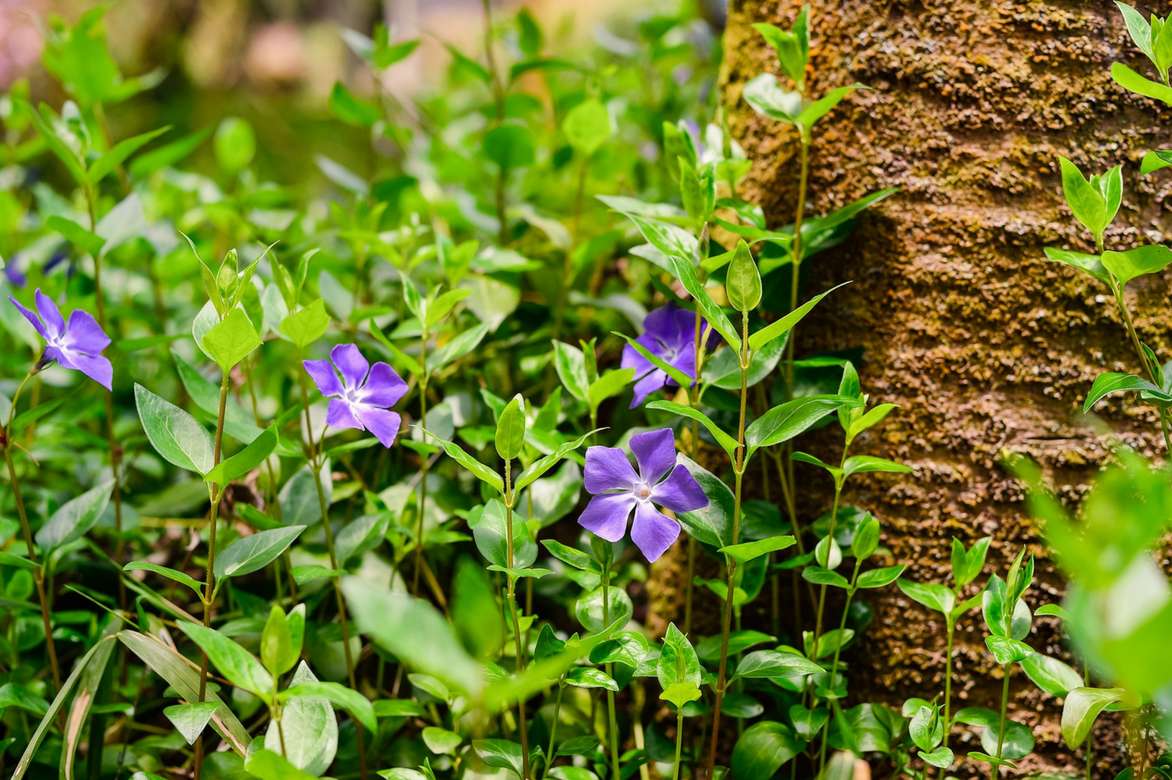
Periwinkle is valuable for colonising the base of trees.
Diseases and potential pests
Little prone to diseases and parasitic infestations, periwinkle is only threatened by rust, which can affect its leaves by forming reddish pustules. While it may be unsightly, the survival of the affected plant is rarely endangered. Cut and then destroy the diseased leaves. Treat this fungus by spraying with nettle or horsetail manure.
Multiplication: propagation by cuttings and division
The periwinkle naturally layers and produces suckers, multiplying through stolons, much like strawberries. Therefore, propagation by cuttings and division remain the simplest and quickest methods for multiplying periwinkle.
How to take a cutting of periwinkle
- After flowering between July and September, take semi-woody or semi-hardwood stems (which transition from softwood to hardwood) of 20 cm
- Each cutting should have at least 3 nodes
- Cut the stem just below the highest node without leaves
- Remove the lower leaves
- Replant 3 or 4 cuttings in a pot 10 cm in diameter in a mixture of turf and sand
- Firm down
- Water the cuttings regularly
- Overwinter them in a frost-free environment under a cold frame
- Replant in open ground the following spring when the soil is well warmed and all risk of frost has passed
Tip: You can also take a small piece of stem with roots and plant it directly in the desired location: periwinkle is a creeping plant that roots as soon as a stem touches the ground!
By division
Proceed in September or April on clumps that are 2 to 3 years old and well established.
- Using a spade, take clumps from the root ball
- Immediately replant these new plants in the garden in well-tilled and well-draining soil
- Water generously
Associating periwinkles in the garden
With its somewhat invasive character, Periwinkle often thrives on its own, spreading across large areas to form bright carpets of blue or white flowers against a backdrop of glossy green evergreen foliage.
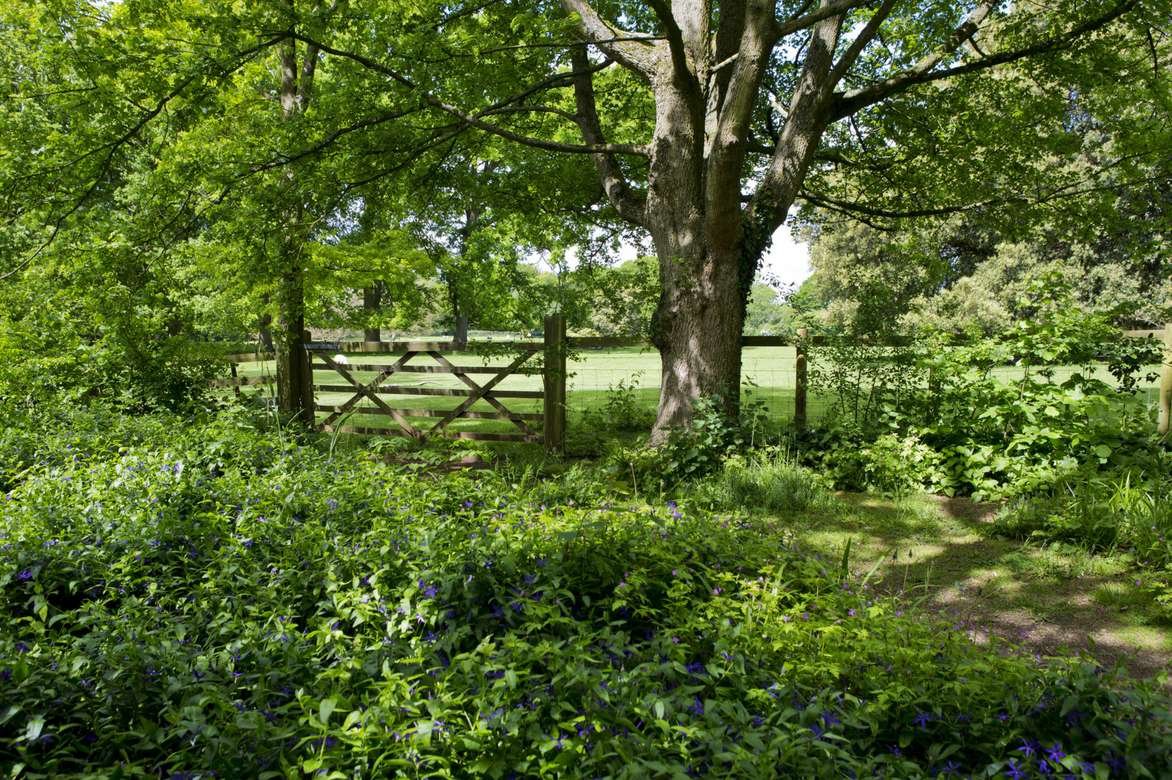
Periwinkles can create large flowering carpets in the shaded and wild parts of the garden.
The flowers of this perennial ground cover will bloom abundantly in a cool, slightly wild woodland for most of spring, surrounded by other shade-loving perennials such as evergreen ferns, Brunnera, or Caucasian forget-me-nots, Japanese sedge, Epimedium grandiflorum or Elf flowers, hardy geraniums, Acanthus mollis, columbines, Solomon’s seal, Dichondra repens, and Romeo’s ruin (Cymbalaria muralis). However, be careful not to compete it with smaller, slower-establishing perennials, as it may smother them.

An example of an undergrowth association: Vinca minor, Geranium phaeum ‘Album’, Epimedium ‘Sphinx Twinkler’, Polygonatum commutatum, Polystichum setiferum ‘Proliferum’, Brunnera macrophylla ‘Jack Frost’.
Common or variegated ivy will make a lovely combination with Vinca with its marginate or cream-veined foliage, as well as with variegated Lysimachia, small hostas, or Japanese herb.
In non-scorching sunlight, white-flowering periwinkles will accompany sun-loving ground covers such as silver baskets, Phyla or Lippia nodiflora, and Leptinella potentillina.
→ Discover more association ideas with periwinkles in our advice sheet!
Useful resources
- Ground cover plants are a valuable aid in the garden; here are our 10 best evergreen ground covers for a low-maintenance garden!
- Long live low-maintenance flower beds!
- To accompany your periwinkles, be inspired by our perennials with early spring flowering
- Our advice sheets: Choosing periwinkles, Pairing periwinkles, and Invasive periwinkle: how to control its spread or eliminate it?
- Subscribe!
- Contents
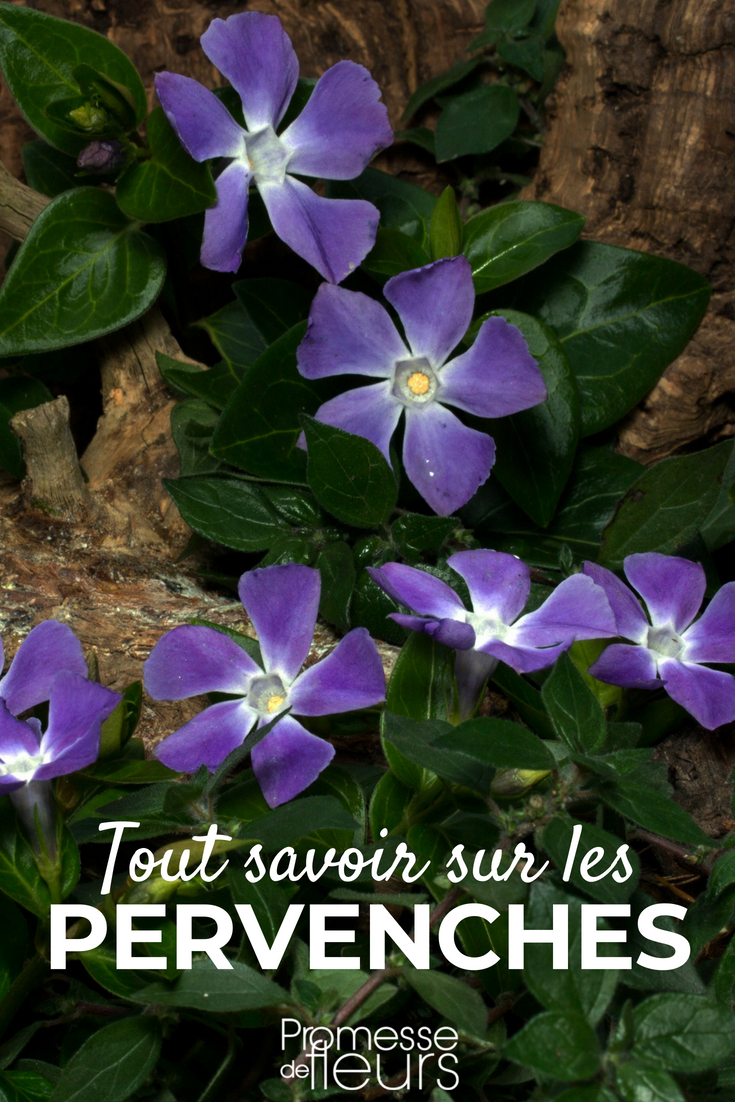

































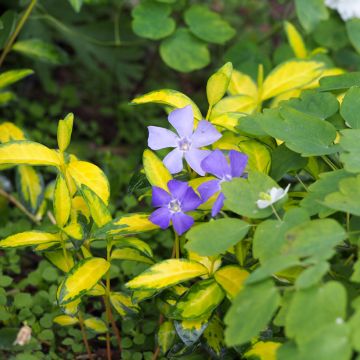
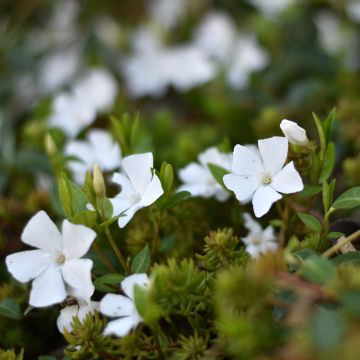
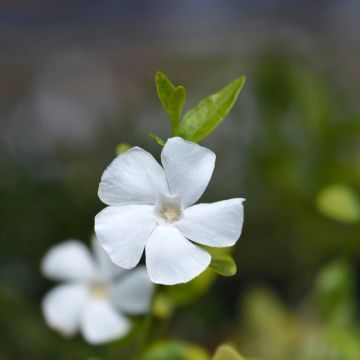

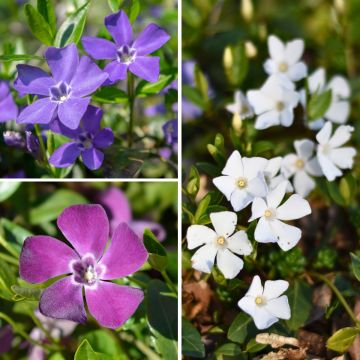
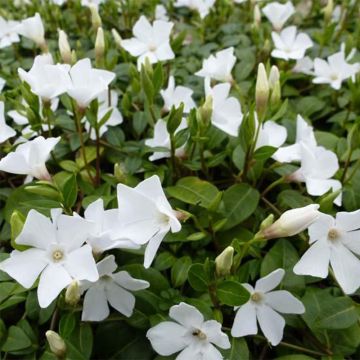
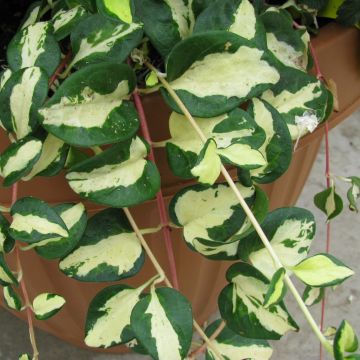

Comments